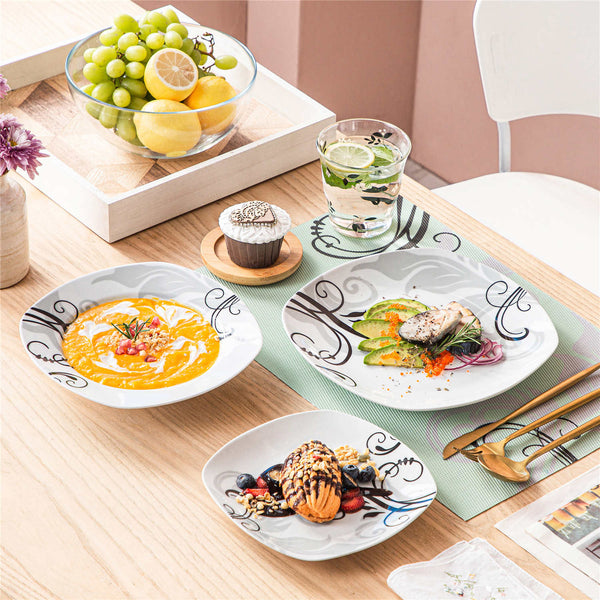How to Safely Use Porcelain Plates in the Oven for Cooking
Porcelain is a durable, shiny substance made of clay heated at high temperatures. Manufacturers use porcelain to make plates, bowls, cups, cookware, dinnerware, and ornaments. Research shows that porcelain plates have a more refined clay with kaolin, feldspar, and quartz materials.
Unlike stoneware or earthenware, manufacturers heat quartz, feldspar, and kaolin at temperatures between 1,200 and 1,450 degrees Celsius. Plates made of porcelain are famous for their durability and non-porous properties. While porcelain plates have a fragile appearance, they possess superior solidity.
An oven is a reliable kitchen appliance for heating and roasting. You can cook casseroles, meat, and baked good, such as cake, bread, and other desserts. However, you must understand what materials you can put in the oven. For instance, some materials can shatter at high temperatures and damage the oven.
Porcelain plates are durable, aesthetically pleasing, and resistant to heat. However, most people ask: "can I use porcelain plates in the oven?" Today's article will answer this question and give essential details on the safety of porcelain plates in the oven. Read on!
The Oven Safety of Porcelain Plates
While ceramic dinnerware is ideal for cooking, roasting, and backing, kitchen users still have confusion about porcelain dinnerware or plates. On the other hand, porcelain dinnerware sets are perfect for decorative purposes, not for cooking.
Not only are porcelain plates durable and elegant for serving food, but they can also withstand high temperatures. Likewise, porcelain plates are oven, freezer, dishwasher, and microwave safe. They are also easy to clean due to their naturally non-stick properties.
Compared to glass plates, you can put porcelain plates in the oven. Although you can also use glass plates in the oven, make sure you use plates made of tempered glass because they can withstand heat up to 470 degrees Fahrenheit or 350 degrees Celsius. Temperatures higher than 470 degrees can shatter glass plates.
On the other hand, porcelain plates are more durable and heat resistant than glass plates because they can withstand high temperatures between 260 and 300 degrees Celsius and 500 to 572 degrees Fahrenheit. Moreover, you can use ceramic plates in your oven.
However, avoid using ceramic plates decorated with adhesive designs. Most ceramic plates are glazed, so you must determine whether they are suitable for use in the oven. Let us discuss the factors that impact oven safety.
Factors that Impact Oven Safety
Porcelain plates are more lightweight, thin, delicate, and translucent than other materials, such as stoneware and earthenware. Most people think that porcelain plates do not go well with conventional ovens.
While this is true to some extent, some porcelain plates are ovenproof, meaning you can use them safely in the oven. We recommend checking for the oven-safe label or symbol when shopping for porcelain plates. Here are the factors that impact porcelain-based plates' oven safety.
Thickness
The thicker the porcelain plate, the higher the chances that high temperatures won't affect it. On the other hand, thinner and more decorative porcelain plates are more vulnerable to damage due to extreme heat in the oven.
So, if you use a thin porcelain dish in the oven, it may break or crack. Porcelain plates without formulated coatings mean the manufacturer had not heated them at a high temperature. So, putting it inside the oven is risky and may damage the oven.
Glazing
Generally, porcelain plates are stable and can resist high heat. These plates do not leach chemicals or harmful compounds into the food. However, before putting the plate inside the oven, you must consider the glazed/unglazed factor.
For example, the glaze used to coat porcelain plates may contain harmful metals like cobalt, lithium, and copper. High temperatures in the oven may seep the metals into food. Leaching usually occurs when the glaze chips or cracks.
Using Porcelain Plates in the Oven
Oven-safe plates have specific properties, such as resistance against high heat, when placed in the oven. These plates are not prone to cracking and chipping, allowing you to warm up a meal on the plate quickly, efficiently, and safely.
Bear in mind that not all porcelain plates are oven safe. Therefore, putting them inside can damage your oven, costing you hundreds of dollars. Follow the tips/tricks below to maintain safety.
Check the Label
Turn the plate over and look for the label "oven-friendly" or "ovenproof" on the underside. It is the simplest way to determine whether you can use the plate in the oven for cooking or baking purposes.
Remember, some companies that make porcelain plates print symbols instead of labels on the underside. Most people do not understand the difference between microwave-safe and oven-safe symbols.
For example, the plate is microwave-safe if it has a symbol that appears like short and horizontal flame/waves. On the other hand, a plate with tall, vertical waves is oven safe. Some porcelain plates have both symbols, indicating they are safe to use in the microwave and oven.
Preheat the Oven
Porcelain is a fragile material and not ideal for cooking at high temperatures. Warming food on a porcelain plate in the oven at sudden high temperatures can lead to thermal shock.
As a result, the plate will break and create a mess in the oven. Therefore, preheat the oven and slowly heat the food on the porcelain plate. The purpose is to avoid thermal shock and maintain safety.
Allow the Plate to Cool Down
When you remove the hot plate from the oven and place it on a cold counter, it will break apart into several pieces due to a sudden change in the temperature. Therefore, do not remove the porcelain plate from the oven immediately.
Instead, we recommend turning off your oven and allowing the porcelain plate to cool down for 15 to 20 minutes. Once the plate cools down slowly, you can safely take it out of the oven.
Alternatives to Using Porcelain Plates in the Oven
If you have purchased porcelain plates from a reputable manufacturer or potter, you can use them in the oven. However, you must follow the safety tips above to prevent unpleasant situations. If you still have doubts and want to avoid breaking the plate or damaging the oven, you can consider alternatives, like:
Metal Plates
Although metal plates are not common, they are ideal for use in the oven. Whether the plate is made of aluminum, brass, copper, stainless steel, or alloy, it is 100% safe for use in the oven.
Metal plates can withstand high temperatures, allowing you to cook, roast, or bake food efficiently and quickly. However, exposing it to high temperatures is dangerous if the plate has a less durable construction with a thin structure.
Cast-Iron Plates
Most people do not use cast-iron plates in the kitchen due to weight. Despite cast-iron plates' less usability, they are excellent for use in the oven. However, you must not use cast-iron plates with decorative elements, paintings, or colors. Otherwise, the heat will peel off the paint/color and release harmful compounds into the food.
Palm Leaf Plates
Palm leaf plates are an excellent alternative to porcelain plates. Not only are these plates environmentally friendly, but they can also withstand high temperatures of up to 350 degrees in the oven. However, you cannot use a palm leaf plate in the oven for more than 45 minutes. Otherwise, the plate may lose its insulation properties.
Final Words
Although porcelain plates are made of natural materials, thinner and glazed plates can leach metals into the food due to high temperatures. Consuming food with metals can cause nausea, vomiting, digestive discomfort, and abdominal pain.
Some metals, such as cobalt, are carcinogenic and can cause cancer. Therefore, you must know the ins and outs of heating porcelain plates in the oven and consider the safety factors discussed in this post. Check out the best collection of porcelain plates with excellent durability, oven-safety properties, and elegance.


























Leave a comment